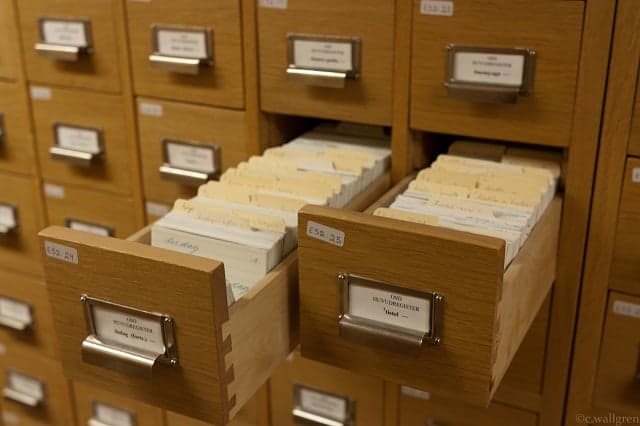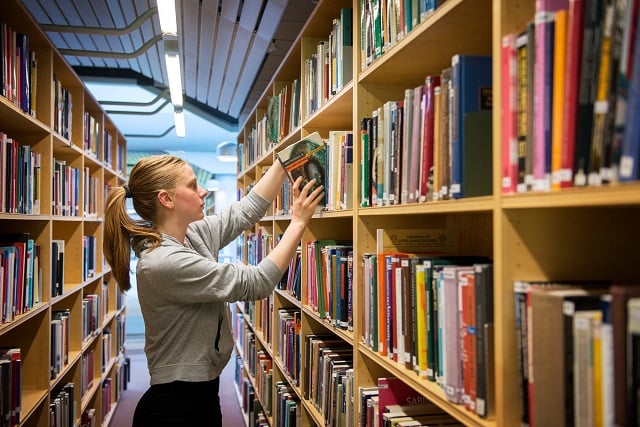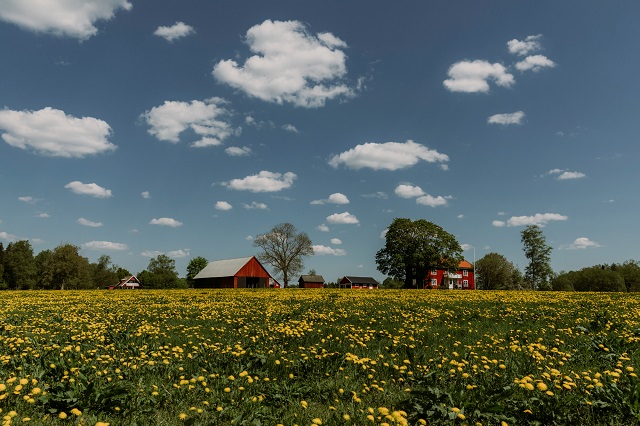Sweden to get its first dialect dictionary in 150 years

A new dictionary of Swedish dialects is being published for the first time in over 150 years. The Local spoke to the linguist overseeing the project about how she's choosing which expressions to include, and learned some of her favourite Swedish dialect words.
This article was written for Members of The Local. Read more Membership Exclusives here.
"When working with the dictionary, we avoid difficult grammatical terms and professional language. We want to try to explain the words in an understandable way," Annika Karlholm, an archivist at the Swedish Institute for Language and Folklore, told The Local.
The last dialect dictionary was published in 1867 by the priest and linguistics researcher J.E. Rietz, Karlholm said. The new work will include explanations of each word's meaning "in a clear way" as well as example sentences showing how it is used.
The target audience is ordinary people who are interested in language, such as students or those engaged in researching the history of their family or local area.
"The hope is that the dictionary can contribute to people taking note of dialects and, perhaps most of all, traditional dialects," Karlholm said. "We are choosing almost exclusively special dialectal words, ie. words that are only in the dialects and which are usually not included in standard language dictionaries."
READ ALSO:
-
The history behind Sweden's town and city names
-
Ten common phrases in Sweden's ancient forest language Elfdalian
-
These 33 words entered the Swedish language in 2018

Photo: Cecilia Larsson Lantz/Imagebank.sweden.se
Some subject areas have more dialect words than others, such as the plant and animal kingdom.
"There are many special dialect words for certain types of plants, birds and insects, for example blåklint (cornflower) which has names like blågubbe, duvustol and åkersilke, and odon (bog bilberry), with names like blåbuk, fyllebär, utterbär and ödbär," said Karlholm.
"Then there are birds, for example spillkråka (black woodpecker) with names like blåkråka, dryp, hålkråka and tillekorp, and the tofsvipa (Northern lapwing) with names like bläcka, hornvipa and tivipa, and insects such as nyckelpiga (ladybird) with names like bobba, fårpiga and åkerhöna," Karlholm listed.
Another rich area for anyone studying Swedish dialects is food and drink, as well as weather. Karlholm highlights different ways of referring to light snow, such as flira and fnyka, or light rain which can be described using the verbs durra, hy, fjuska, and puska in different parts of the country.
So, which region has the richest dialect? It's Småland, best known outside Sweden as the home of both Ikea and children's author Astrid Lindgren, that has by far the most unique dialect words in the dictionary, according to Annika.
However, she stresses that this has more to do with regional differences in how dialectal words have been recorded, rather than any innate difference in the dialects.

A traditional farm house in Småland. Photo: Alexander Hall/imagebank.sweden.se
When asked her favourite word in the collection so far, Annika picked out treakel which means liquorice.
"In ancient Swedish, treakilse meant 'antidote' but has, over time, come to refer to sweet liquorice in dialect. The reason for the development of the word is probably that liquorice has previously been used as a medicine," she explained.
"Another word with an interesting etmology is tabberas, today best known from Astrid Lindgren's depiction of Emil i Lönneberga in the chapter Stora tabberaset i Katthult," the archivist said.
"Tabberas comes from the older Swedish word tabelras, which is linked to the French expression table rase, which in its turn comes from the Latin tabula rasa (wax painting with deleted writing). In older Swedish, tabelras was a term for card games with the meaning 'everything is taken away, nothing is left, clear house'. This meaning has then been further developed in the dialects."
Because of the meaning 'clean table', tabberas is used in dialectal Swedish today to refer to a party, restaurant or event where all the food provided is eaten. In the Astrid Lindgren story, the character Emil puts on a party for poorer neighbours and serves all the Christmas food in the house.
Work on the dictionary began ten years ago, using the institute's language archives, and is expected to be complete by around 2027. But even before that date, parts of the dialect dictionary will be published on the institute's website.
Comments
See Also
This article was written for Members of The Local. Read more Membership Exclusives here.
"When working with the dictionary, we avoid difficult grammatical terms and professional language. We want to try to explain the words in an understandable way," Annika Karlholm, an archivist at the Swedish Institute for Language and Folklore, told The Local.
The last dialect dictionary was published in 1867 by the priest and linguistics researcher J.E. Rietz, Karlholm said. The new work will include explanations of each word's meaning "in a clear way" as well as example sentences showing how it is used.
The target audience is ordinary people who are interested in language, such as students or those engaged in researching the history of their family or local area.
"The hope is that the dictionary can contribute to people taking note of dialects and, perhaps most of all, traditional dialects," Karlholm said. "We are choosing almost exclusively special dialectal words, ie. words that are only in the dialects and which are usually not included in standard language dictionaries."
READ ALSO:
- The history behind Sweden's town and city names
- Ten common phrases in Sweden's ancient forest language Elfdalian
- These 33 words entered the Swedish language in 2018

Photo: Cecilia Larsson Lantz/Imagebank.sweden.se
Some subject areas have more dialect words than others, such as the plant and animal kingdom.
"There are many special dialect words for certain types of plants, birds and insects, for example blåklint (cornflower) which has names like blågubbe, duvustol and åkersilke, and odon (bog bilberry), with names like blåbuk, fyllebär, utterbär and ödbär," said Karlholm.
"Then there are birds, for example spillkråka (black woodpecker) with names like blåkråka, dryp, hålkråka and tillekorp, and the tofsvipa (Northern lapwing) with names like bläcka, hornvipa and tivipa, and insects such as nyckelpiga (ladybird) with names like bobba, fårpiga and åkerhöna," Karlholm listed.
Another rich area for anyone studying Swedish dialects is food and drink, as well as weather. Karlholm highlights different ways of referring to light snow, such as flira and fnyka, or light rain which can be described using the verbs durra, hy, fjuska, and puska in different parts of the country.
So, which region has the richest dialect? It's Småland, best known outside Sweden as the home of both Ikea and children's author Astrid Lindgren, that has by far the most unique dialect words in the dictionary, according to Annika.
However, she stresses that this has more to do with regional differences in how dialectal words have been recorded, rather than any innate difference in the dialects.

A traditional farm house in Småland. Photo: Alexander Hall/imagebank.sweden.se
When asked her favourite word in the collection so far, Annika picked out treakel which means liquorice.
"In ancient Swedish, treakilse meant 'antidote' but has, over time, come to refer to sweet liquorice in dialect. The reason for the development of the word is probably that liquorice has previously been used as a medicine," she explained.
"Another word with an interesting etmology is tabberas, today best known from Astrid Lindgren's depiction of Emil i Lönneberga in the chapter Stora tabberaset i Katthult," the archivist said.
"Tabberas comes from the older Swedish word tabelras, which is linked to the French expression table rase, which in its turn comes from the Latin tabula rasa (wax painting with deleted writing). In older Swedish, tabelras was a term for card games with the meaning 'everything is taken away, nothing is left, clear house'. This meaning has then been further developed in the dialects."
Because of the meaning 'clean table', tabberas is used in dialectal Swedish today to refer to a party, restaurant or event where all the food provided is eaten. In the Astrid Lindgren story, the character Emil puts on a party for poorer neighbours and serves all the Christmas food in the house.
Work on the dictionary began ten years ago, using the institute's language archives, and is expected to be complete by around 2027. But even before that date, parts of the dialect dictionary will be published on the institute's website.
Join the conversation in our comments section below. Share your own views and experience and if you have a question or suggestion for our journalists then email us at [email protected].
Please keep comments civil, constructive and on topic – and make sure to read our terms of use before getting involved.
Please log in here to leave a comment.